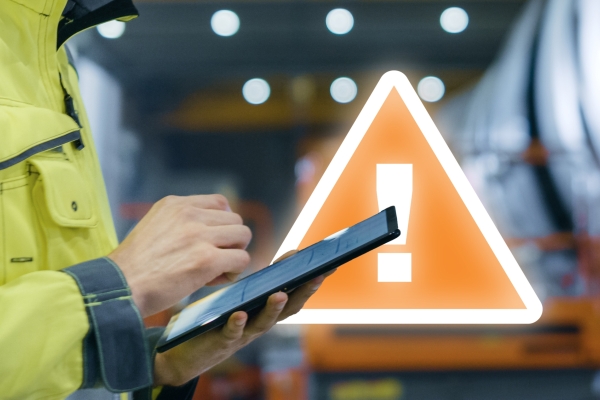Video-based remote support tools are quickly transforming industries around the globe, with Gartner estimating widespread adoption in the next 2-5 years. In the rush to add video to your service options, thinking of it as just another added feature can often lead to failure. When deployed correctly, remote visual support will net substantial ROI for service organizations, improving key metrics while reducing truck rolls. Before getting started, we suggest asking the right questions to find the best solution for your needs. Here are five of the most common mistakes we see:
1. Thinking of remote visual support like Skype or Facetime
Remote visual support isn’t simply a video call. It’s a platform built with a powerful set of features to help you see a problem someone is facing and guide them to a resolution more quickly.
Rather than just explaining the problem over a visual support call, an on-site technician or customer can show the problem or task to an expert located anywhere. The remote expert isn’t just a voice or a face asking questions. With a powerful platform like SightCall, they can control the on-site technician’s phone to zoom in, activate the flashlight, and take photos of what they need.
Using the Optical Character Reader, the remote expert can capture text from serial or model numbers to quickly reference. If there are instructions or relevant materials, the expert can drop those documents into the call instantly for the on-site user to reference.
The remote expert can also use AR features and annotations to draw or illustrate right on the on-site device. With just a video call you’d still end up spending a lot of time saying things like “Look for the panel at the top right.” With annotations and other tools, the expert can directly markup the video image to illustrate live the steps to resolving issues in much the same way as if they were on-site themselves.
In addition to these features allowing clear communication and collaboration that recreate in-person conditions, they go beyond by seamlessly folding in the data from the session into the existing workflow. Once a task is completed the video and photos taken during the session, along with any resources shared, are saved right into the work order for future reference.
2. You’re trying to build your own visual support platform
Over the last ten years, we’ve sat at the table with countless corporations, system integrators, and CRMS that have tried to create their own live video support tool. They’ve spent millions on development and millions on research. They’ve been told it can’t be done for many reasons, including that they wouldn’t be able to support the product even if they can produce it. Building and maintaining a communication platform isn’t a do-it-yourself solution. We don’t build our own fax machines, phones, or email systems. We rely on experts to do it for us.
Using a robust and proven solution like SightCall allows you to kickstart your digital transformation in a way that integrates into your established tools and workflows. Built by telecom experts, we own, manage and operate our own platform, giving us the freedom to continually evolve and set the standard for visual assistance. Customers can leverage our pre-built partnerships, deploy on our standalone platform or create a custom branded and white-glove application with our technology.
3. You’re making your customer and service agent the “face” of visual support
Unless you need to confirm someone’s identity or have a telemedicine use case, there are few reasons why face-to-face matters in service operations. With remote visual support, using the rear-facing camera is key. It’s more important to see what the on-site person sees than their face. The goal is to have an illustrative conversation using a combination of tools to inspect and evaluate an issue and offer solutions.
Take a lesson from Amazon’s failure with Mayday. Launched in 2013, Amazon Mayday was a support tool that initiated a face-to-face video interaction between customers and customer service. Studies show that customers are more inclined than ever to try and “self solve” problems – one reason being that they don’t want another person in their home. If the use case doesn’t require being face-to-face, scrap it for a use case that makes sense.
4. You are unaware of your compliance obligations
In every industry, there are regularly updated guidelines and requirements for security and data protection that require compliance. Video call software such as Skype, Facetime, or Whatsapp, is used widely for personal communication but isn’t robust enough to protect the data of your customers or employees. Dedicated solutions for remote visual support are built on systems that prioritize safety and compliance.
For anyone in the healthcare industry, HIPPA (Health Insurance Portability and Accountability Act) compliance is not optional. It consists of a series of interlocking regulatory rules that protect patients, physicians, and all healthcare providers. SightCall has been designed specifically to offer visual remote support consistent with full compliance with these regulations, empowering telehealth services, medical equipment servicing, and healthcare sales and services with powerful virtual tools.
Other industries require compliance with GDPR, CCPA, or similar regulations. SightCall prioritizes security and compliance that exceed industry standards, as demonstrated by an annual SOC 2 Type II Certification – an independent verification based on trust services criteria.
5. You’re not integrating remote visual support into your current business process
Implementing remote visual support as a separate system from your regular business processes will lead to problems of redundancy and inefficiency. Siloed data will prevent your remote experts from having the information they need to assist end-users, and data gathered from the video session will be similarly limited unless manually entered back into the CRM or ticketing system.
By integrating visual assistance into your existing systems and processes, you ensure not only that all data is in one place, but also that you can measure the success of your virtual tools. SightCall’s flexibility and integrations enable video sessions to be launched from within the platform of record. Whether you’re using Salesforce, ServiceNow, ServiceMax, Zendesk, or a proprietary system, by using the platform within your workflow you reduce barriers to adoption and can access what you need to ensure success.
Choosing the right visual assistance solution is more than adding video to your existing model. Avoiding these common mistakes will allow you to quickly reap the benefits of remote visual support including increasing customer satisfaction and productivity by leveraging experts with less physical travel to resolve issues or complete tasks quickly the first time.
To learn more, see how SightCall has successfully transformed support for companies like Koenig & Bauer and contact our team of experts to discuss your visual assistance needs.



